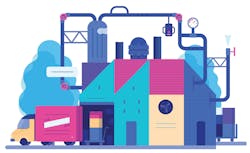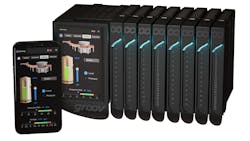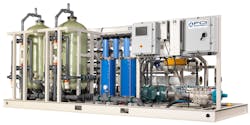IIoT Enables Next-Level Remote Asset Monitoring
FCI Watermakers’ large-scale, reverse osmosis systems—which convert sea water to fresh water—are typically found in the most out-of-the-way locations, from off-shore oil rigs to far flung island resorts. Until recently, however, the manufacturer had no reliable way of monitoring or troubleshooting remote assets. When a system would fail, an experienced technician would have to make the onerous trek to a customer site to get the assets back in working order.
Those high-stakes adventures came at a high price—both financially and as a potential ding on customer service. “We had no idea how a system was running, and if and when there was an issue, we’d get a phone call from a guy on the ground who had no idea what they were looking at,” says Mark Ajemian, senior mechanical engineer at FCI Watermakers. “That made it hard to troubleshoot the problem remotely. We’d typically have to fly someone out there to resolve the situation, and customers would incur a heavy cost.”
FCI Watermaker’s remote service challenges are being resolved as the Industrial Internet of Things (IIoT) comes into sharper focus and paves the way for new connectivity and intelligent offerings that propel remote asset management to the next level. FCI has incorporated Opto 22’s groov EPIC (edge programmable industrial controller)—a bundle of industrial-grade hardware, software, human-machine interface (HMI), and communications capabilities—into its reverse osmosis systems. As a result, the OEM is now able to monitor customers’ systems in the field remotely, gaining a direct view into critical attributes like flow, pressure, and water quality so it can stay abreast of any alarming changes and troubleshoot units from afar in conjunction with local facilities managers.
“This changed the game on how easy it is to incorporate remote access features into a PLC [programmable logic controller],” says Ajemian, adding that the availability of groov View HMI on a standard mobile device made it easy for FCI Watermaker to create an app that allows remote customers to follow along. “It’s not only easy from a programming standpoint, it’s also easy from a user standpoint as they can simply download an app on their phone,” he says.
Like FCI Watermakers, a growing number of OEMs are leveraging IIoT and other control technologies to advance remote management of industrial assets to enable better customer service. They are also beginning to experiment with how to leverage the technologies to offer new maintenance services to create additional revenue streams.
Simultaneously, manufacturers with multiple plants are taking advantage of the same ease of connectivity, new cloud platforms, and analytics capabilities to remotely monitor, manage, and maintain plant floor equipment from a centralized location, across multiple sites. Multi-site manufacturers are also consolidating data from a portfolio of remote assets and marrying it with other sources of information—weather conditions and enterprise platform data, for example—using the Big Data mashup to contextualize insights and enable new use cases in areas like predictive and preventative maintenance.
While, by and large, remote connectivity to plant floor assets and their corresponding data reserves has existed for some time, visibility has been limited to equipment largely contained within the domain of a specific plant with minimal visibility to the larger landscape or across multiple plants. In addition, device management has been just that—contextualized to a specific device. Yet, as IIoT ushers in more intelligence and greater connectivity, it fosters a broader view that can arm manufacturers with better insights to improve processes, minimize downtime, and reduce choke points and throughput issues in the plant.
“Companies are better able to identify pain points and be more effective,” says Ante Tomicic, product manager, application support services for Rockwell Automation. “They gain valuable insights from more assets rather than remotely troubleshooting a single device that failed based on feedback.”
At the same time, IIoT’s ubiquitous connectivity means manufacturers can consolidate a team of experts who can solve problems and optimize asset performance for remote sites from a centralized location. “Previously, they would have to have a subject matter expert (SME) in each plant, which would require their domain expertise footprint to be much larger,” says Phil Bush, product manager, managed services at Rockwell. “Now, not only could an SME know what action needs to be taken to optimize their filler machine for the production environment, for example. They could potentially remote into that machine and do that optimization activity themselves.”
Add emerging technologies, like augmented reality (AR), to the mix, and the use case becomes even more valuable to manufacturers with multiple sites and OEMs looking to raise the bar on maintenance services, Bush says. AR enables what Bush calls “over the shoulder” video annotation-style work instructions to be delivered to a remote plant operator, allowing them to perform the maintenance operation more successfully. This is a big area of focus as part of Rockwell’s partnership with PTC (for more information on this, visit: http://awgo.to/rockwellptc). “AR would further reduce the time it takes to resolve issues because both [the plant operator and expert] are looking at the same thing at the same time and can articulate what needs to be done in a way that isn’t captured in a phone call,” Bush explains.
Connectivity the old way
Not only does IIoT enable increased visibility for remote asset management, it also helps mitigate a lot of the long-standing complexities surrounding connectivity of remote assets and their discrete data silos. Most plants are already subsumed with keeping internal operational systems up and running, let alone building out their own networking capabilities to tap into remote assets. In addition, many small and mid-size manufacturers simply don’t have the resources or information technology (IT) expertise to handle the tough integration work of getting time series and sensor data flowing in and out of proprietary control systems so it can be consolidated, managed, and leveraged for insights related to operational performance and system uptime.
The longstanding divide between operational technology (OT) and IT hasn’t made things any easier. While manufacturers have remote asset management in their sights, the availability of dedicated IT personnel or a technical staff to facilitate and understand what is happening has held companies back, according to Benson Hougland, vice president of marketing and product strategy at Opto 22. “They would have to put in PCs, routers, and gateways, and it’s been too difficult with the lack of available IT staff or skill sets to maintain the remote communications capability just to tap into what’s happening in the plant,” he says. “It’s a cobweb of various technologies—a pretty significant sized plant might have the right IT resources, but if you’re a raw materials facility, you don’t have a lot of expertise so the cost of obtaining the data outweighs the value of it.”
Opto 22’s groov EPIC platform flattens the architecture, changing the return on investment (ROI) model for remote access management, bridging OT/IT convergence, and facilitating remote equipment communications, Hougland claims. The platform ensures security via a built-in virtual private network (VPN) client while support for Node-RED and the MQTT publish/subscribe communications protocol facilitates data exchange between legacy PLCs and control systems, cloud platforms, and web services without requiring a direct connection to the corporate network.
Trading up the old way of remote site monitoring via cell phones and VPNs for capabilities built on IIoT infrastructure and message brokers like MQTT is more palatable to companies who may have balked at giving OEMs and machine builders access to their corporate networks, notes Daymon Thompson, software product manager at Beckhoff. “Now you can take multiple facilities or OEM machines that don’t live in one facility and aggregate data back using the cloud,” he explains. “It allows for a centralized location—a demilitarized zone, if you will—where disparate equipment can be connected in the cloud and OEMs no longer have to VPN or tunnel into users’ networks. Some users have major concerns when you’re pooling machines from 20 to 40 OEMs; they’re not comfortable giving OEMs direct access or managing that many VPN connections or inputs.”
In addition to connectivity improvements, advances in wireless sensors and cloud analytics are enabling new forms of continuous monitoring of remote assets for predictive maintenance and performance management versus what used to be limited to manual check-ups. The ability to continuously monitor and analyze vibration or pressure data coming from a heat exchanger or piece of rotating equipment in the field provides better insight into the health and status of the equipment, allowing users or OEMs to detect problems earlier, says Mike Boudreaux, director of product management, cloud services and solutions at Emerson Automation Solutions.
“It’s about measuring new things as well as replacing manual data collection with continuous data collection, which provides better visibility into the data with better certainty as to what you’re looking at,” Boudreaux explains. “If you’re manually collecting time series data once a month, there is no visibility into what happens in between those collection points, and it’s subject to human error.”
Calling new business models
While manufacturers have generally understood how they might benefit from remote asset management services, many have been reluctant to let vendors connect into their networks due to security concerns. Plus, some are not yet convinced there is a clear reason to do so, contends Vishal Prakash, product manager at ProSoft Technologies, a division of Belden. Typically, the plant manager would control when and for how long an OEM was able to remotely connect to an industrial machine, opening up access through the network when there was a specific problem in need of troubleshooting—a scenario that hampers any ability to deliver predictive maintenance services.
“Conditions in a plant could change very quickly and, if they were in the midst of an upgrade or changing processes, they don’t particularly want a system integrator or machine builder to connect to their automation devices and effect the process,” Prakash explains. To address those concerns, the company offers ProSoft Connect, a cloud-native remote connectivity platform built with a multi-layered approach to security, support for REST APIs, and a Virtual Lockout-Tagout feature that allows for dynamic authorizations of remote access for a specified period of time, giving users greater control of determining access. “This makes it so operational data is easily available and can be retrieved by an enterprise system” to populate dashboards that make it easily consumable by non-technical personnel, he says.
While IIoT-enabled remote asset management offerings promise a whole new level of operational efficiencies, there’s a longer-term opportunity for OEMs to shift to as-a-service business models for a broad set of industrial equipment. Take bearings, for example. SKF saw an opportunity to provide customers with more reliable rotation as opposed to selling them more bearing hardware. Using Siemens’ MindSphere Internet of Things (IoT) platform to collect and analyze data from instrumented remote equipment such as conveyor belts, electric motors, and other machinery, SKF has developed a pilot program to offer customers long-term contracts for bearings “as a service,” paid as a monthly fee and based on agreed-upon performance metrics such as hours of rotation.
“MindSphere provides a common environment for both the customers and a vendor like SKF to see the same data and performance. So there is no suspicion about trying to upgrade a plant and refurbish machines before it’s needed,” says Bill Boswell, vice president of marketing, cloud application solutions—MindSphere at Siemens Digital Industries Software. “IoT provides a common view that was hard for people to have before.”
While FCI Watermaker is interested in the as-a-service concept to unleash new revenue streams, for now the company believes the ability to offer remote asset management capabilities to customers is enough of a differentiator and a key competitive edge. “Remote monitoring makes our product a better product,” says Ajemian. “Whenever you are able to see data in real time, the mindset is that you take better care of the product. You see things before they happen so you’re able to prevent problems and keep everyone happy.”
About the Author
Beth Stackpole, contributing writer
Contributing Editor, Automation World

Leaders relevant to this article:


